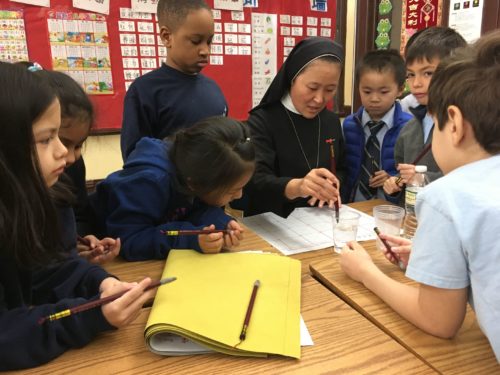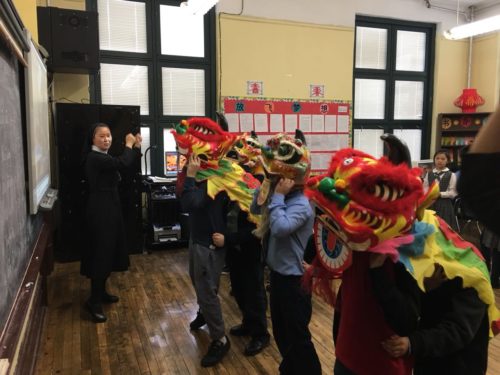
FLUSHING — More than 67 million Americans speak a language other than English at home, but at St. Michael’s Catholic Academy in Flushing, which is majority Chinese, there’s no language barrier thanks to the school’s Mandarin immersion program.
Starting in kindergarten and until the third grade, classes are taught half in English and half in Mandarin. In the fourth through sixth grades, about 30 percent of instruction time is in Mandarin, and in the seventh and eighth grades, students have two Mandarin classes a week.
St. Michael’s is the only Catholic elementary school in the state that has a dual English-Mandarin program, which was first developed by Boston College and has been used at St. Michael’s for the past seven years.
The program is for both native English speakers and students who speak Mandarin at home. In some classes, native English speakers are paired with native Mandarin speakers so that the students can learn from each other.
“We have found the majority of Mandarin-speaking students cannot read or write in Mandarin, but only have conversational skills,” Maureen Rogone, the school’s principal, said, explaining that those students learn to read and write in Mandarin at St. Michael’s.
“And for students not having Mandarin as their primary language, learning a second language in a program increases their cognition-cognitive skills, which will enhance their learning,” she said.
“Aside from the academic benefits of learning Mandarin through immersion, we are preparing our students to be competitive world citizens who can understand and accept the cultural diversity and beauty of this diversity of their classmates.”
Students also receive lessons in Chinese history, culture and literature.

“All teachers are speaking Mandarin as much as we can in class, in the hallway and lunchroom as well as recess time. We will try to make it comprehensible in different ways, such as using visual support or physical movement [body gestures]. We will translate into English, too, if needed,” said Sister Martina Hou, who teaches classes in the second, third and seventh grades.
“We do this because we want to provide a Mandarin environment for our students … Tomorrow’s leaders must be able to compete, work and thrive in a globalized world with diverse, multilingual consumers and economies in which China and the U.S. will continue to be major players,” Sister Martina, who hails from Baoding, south of Beijing, said. She came to the U.S. in 2014.
The school integrates faith into the immersion program, in part by starting each class with prayers in Mandarin.
“I teach them Tao Te Ching (an ancient Chinese text about integrity), Confucius and Three-Character Canon (a Chinese classic for young children),” Sister Martina said. “These traditional Chinese cultural values are very similar to Catholic Biblical values.”
Nina Sun, who teaches kindergarten at St. Michael’s, tutors Chinese language arts, math, social science and religion in Mandarin. She enjoys seeing students perform in Mandarin at school concerts and at a Chinese New Year celebration.
“I am happy to see the students’ growth every day. On one hand, they got better understanding in the content area and are able to gradually communicate in two or more languages. On the other hand, they know more than one culture, they started to understand how different people are thinking,” Sun said.
“And the moment I see my students are proud of themselves that they are able to say, to read, to count, to complete their works is the greatest for me.”
